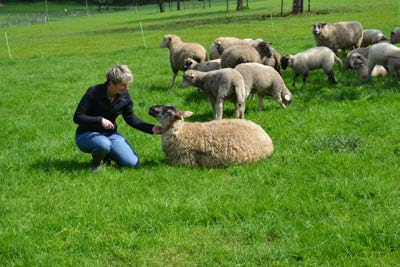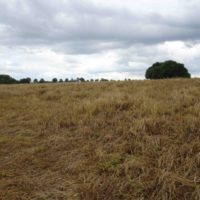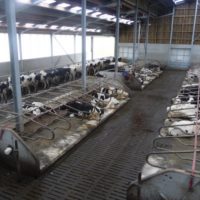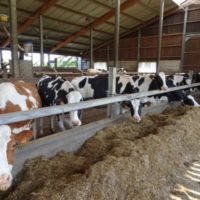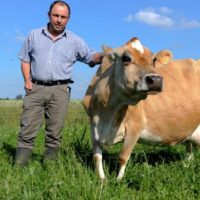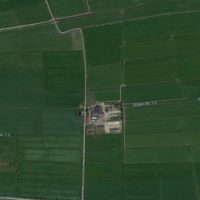Feeding meat breeds with meslin, an excellent way for autonomy and resilience
Farm: “Catherine Faux”
Location: Strée (Beaumont), Belgium
Case study
 Feeding meat breeds with meslin, an excellent way for autonomy and resilience (.pdf)
Feeding meat breeds with meslin, an excellent way for autonomy and resilience (.pdf)
Description
Background
Catherine’s farm located near the municipality of Beaumont (Belgium), a rural area dedicated mainly to husbandry. Catherine’s farm (in organic conversion for 2 years) is a mixed farm with meat breeds of ewes (Ile de France and Entre Sambre and Meuse) and cows (limousine) regularly grazing together on 42 hectares (1 FTE). Catherine took back the farm 8 years ago. The farmer’s strategy focuses on farm autonomy, the short chain of marketing and is characterized by a great deal of curiosity in the field of grassland management and the technical aspects related to grassland management. Catherine develops the production of meslin (mixture of straw cereals and legumes).
Detailed description
For three years, Catherine has been experimenting with different practices in order to develop the fodder and protein autonomy of the farm, while limiting the inputs:
- Production of different types of meslin for mowing and harvesting:
- Oat / triticale / peas => Feeding lambs from 1 month old (slaughter at 4 months, never completely weaned)
- Spelt / oat / triticale / vetch => feed for ewes => diversity of feeds, positive impacts on animal health
- Dual purpose management of legumes and forage mix components (eg production of triticale and organic peas that can also be sold outdoors = adjustment variable)
- Grassland improvement by oversowing, for example through the use of Sencier blends
- Choice of breeds of animals (hardiness, ability to value different types of fodder)
- Improvement of the practice of rotational grazing: adjustment of the plot by block of 1 hectare (the cows remain 4-5 days on each block). Standard = 1 are per cow and per day and equipment of each block with a trough. Permanent grassland, are both grazed and mowed (4 times a year) The duration of permanent meadows is greater than 20 years.
Results
- The goal of autonomy is achieved (no purchase of food, except in 2018). All foods are homemade. Profitability is good despite the organic conversion period (no premium). Comparative trials were carried out to measure the economic interest of the meslin: the growth of lamb fed with meslin (14% protein, 160 € / ton) and with a commercial food (17-18% of protein, under -products, € 307 / ton) was compared. The quantities ingested and palatability are identical and the growth obtained equivalent.
- Grassland quality (species composition, nutritional value) is improved
- The quality of meat production (taste, nutritional value, etc.) marketed in particular through the Coprosain cooperative is appreciated
- Various elements are put forward by Catherine to justify the interest of producing meslin:
- It does not require inputs, just manure
- The amplitude of the dates for meslin implantation makes it possible to sow it even late
- The meslin quickly covers the soil after implantation and grows rapidly in the spring, ensuring good weed competitiveness.
- Complementarity of species within cereal / protein-crops mixes allows better resistance to diseases.
- The adaptability and flexibility of the crop allows harvesting at different times depending on the objective pursued.
- Early harvest will allow to plant a summer crop under better conditions (moisture and soil structure).
- The meslin provides security to the fodder system because the implantation, harvesting and valuation modes are multiple. Harvested in late spring, it is generally not subject to water stress.
- Meslin is usually a forage well balanced in nitrogen and energy.
- Rich in fibber, it promotes rumination. Harvested early and rich in legumes, it contributes to the protein’s autonomy of the ration.
- The place of a meslin in the rotation is flexible
- After a meslin, one can plant a meadow, a straw cereal or a spring crop but also another catch crop or an intermediate crop (depending on the date of harvest of the meslin). The meslin also has the advantage of making available the plot early and without crop residues.
- Finally, in terms of biodiversity, the meslin offers a shelter and a cover diversity to the insects and birds: “it is the feast for bees and the swallows”
- No need to mix the food (chopped on the field)
- Storage of immature meslin in “sausage shape” plastic wrap can “save the day” in case of climatic problems.
Adoption criteria
- Beyond the aspects mentioned in point 3, the meslin is inexpensive to produce, but it is adapted to rustic animals (low needs), not for dairy cattle. The financial aspect can therefore be a factor favouring the adoption of the meslin.
- The tonnage harvested (1 ha of meslin gives 4-5 tons) can on the other hand constitute a psychological barrier for some farmers
- The cost of seeds is a constraint. Catherine and her husband are looking for solutions to produce their own seeds (difficult to sort because constituted of 5 different seeds, another constraint) => Next step in the process of autonomy: seed autonomy.
Future prospects
Various reflections/thinking still need to be made to improve the system:
- How to better manage climate hazards? Is overseeding a solution? To be investigated…
- Are the species used for meslin production optimal, adapted to local conditions? It is necessary to build a baseline on the subject
- The cost of seeds for meslin production is a drag. What steps to initiate, what solutions to implement to produce optimal seeds autonomously, adapted to local conditions?
- The construction of a knowledge base is important: calculating profitability, monitoring the growth curves of the animals fed with the meslin according to the types used, the type of cattle and its stage of development, etc.
Additional information
| Farming system | organic farming |
|---|---|
| Main types of animal | beef cattle, meat sheep |
| Country | |
| Product type | Case study |
| Language | |
| Main domain of innovation | Animal management, Breeding advance, Forage, Improvement of grassland management, Improvement of marketing, Legume management |
| Climate | |
| Soil Type |

